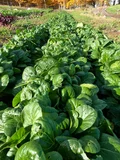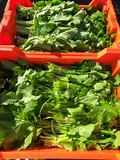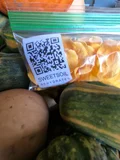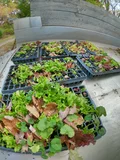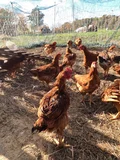TL;DR
We harvested tatsoi, broccoli rabe, italia sweet peppers, and leeks. Then we cleaned onions and weeded. This could have been one of the best days so far on the farm. I get to go back again tomorrow but that doesn’t change how great the weather was today.
Should Raw Onions Require a Culinary Permit?
The onions we planted in April through June, all 13,500 of them, have now been harvested, many of them drying out as storage onions in the shed and barn. It’s not easy to admit it because I am a cook and a farmer, but I hate the taste of raw onions. Every other way…boiled, sauteed, roasted, mashed, fried, pickled, even dehydrated…I love them all except for raw under very specific circumstances. Some people like onions raw…I don’t get that…but I understand people have different tastes, however bad they may be.
There are a few uses of raw onions I permit, such as finely diced and sprinkled on a stadium hot dog or a burger…but this also requires catsup, mustard, relish and maybe even cheese; without these other condiments, it’s just plain savagery. In a pinch when you don’t have shallots lying around, a teaspoon of finely minced onions can go into a jar with oil and citrus juice, a pinch of salt and pepper, maybe a small dollop of coarse mustard then all shaken to make a salad dressing. But that’s it; we draw the line here and no farther.
Shaving them with a mandolin and then tossing them on top of a salad should be a considered a criminal offense…or at least a misdemeanor. Chopping them to serve at a party without application of medium heat and a lipid for at least 4 minutes is right out. For gods’ sakes, you could even put them in a ceviche so long as the acid has had time to cure the seafood. If you leave a sandwich wrapper in an office waste bin after lunch, I’m coming down there for you and we’ll have a go at each other in the parking lot.
Caterers and shops providing platters: for the dear love of all that is sacred in the world, seal the onions in their own containers and most certainly never put them adjacent to any other food without proper packaging. Why sell anything else only for every other food on the planet to become permeated with the smell of raw onions? If this happens in my order, that’s the last time I’m ordering from you not simply because my tongue is offended, but more because it shows how careless and in poor taste you operate your business. Again, the onion isn’t the problem, it’s the lack of competence to use it raw under most circumstances which needs to be addressed. Savages.
Of course, there are times when I throw all those rules and cautions to the wind, and knowing full well what I’m getting into, I bite into one of the farm’s pearl-size onions for a swift kick to the senses. This is not something a robot can understand, the sensation of having one’s nostrils cleared in an instant, the pungent and sticky taste of it on your fingers after a few minutes. I know, I know, but sometimes you just have to hit your own thumb with a hammer to remember why you don’t do such things.
Let’s see what a robot has to say about the humble onion:
A Robot’s Ode to Onion
O humble orb of layered grace, Your skin—papery gold, thin lace— Conceals within concentric song, A sweetness sharp, both right and wrong, The kitchen’s heart, the field’s embrace.
You rise from seed through secret codes, Rooted deep in earthy odes; From cotyledon to sturdy shank, You drink the rain, the soil you thank, A photosynthetic symphony unfolds.
Your bulb, a vault of flavor’s lore, Built cell by cell from sun and store; Fructans guard your winter sleep, While sulfur’s kiss makes poets weep, And cooks rejoice when they explore.
In rows you cure beneath the breeze, Your skins dry tight with practiced ease; Through frost and time your bounty stays, A promise held for colder days— A sun distilled in quiet peace.
O Allium, star of dawn’s own hue, Your flowers crown the summer’s view; In scent, in tear, in layered art, You humble and exalt the heart— Forever simple, endlessly true.
AI Summary from Field Notes
Well I learned a few things from the above experiment:
- The writers of Data’s character on Star Trek: The Next Generation were 30 years ahead of their time
- The ‘cotyledon’ is the first leaf of a seedling, and it’s a crucial part of the plant’s development.
- ‘Fructans’ are a type of sugar that are stored in the onion bulb and are responsible for its sweet taste.
But really, how easy will it be for me to remember these terms if I didn’t do the research myself and only relied on an LLM to further elaborate on what they are? This is the problem being addressed by the farm intern’s daily notes. The intern is taking the time to write down what they learned each day, and this is helping them to remember the information better.
This is also why studies have found that AI makes you stupid, specifically the more you use it for tasks you shouldn’t or don’t have to. By ‘stupid’ I mean it exactly how Linus Torvalds would say it: “It’s not stupid, it’s just not smart”, or in other terms “hampering the development of critical thinking, memory and language skills”.
So while AI, specifically the current incarnation of LLMs, is a novelty for many casual users right now, it’s also inherently harmful to the process of exercising the wet wiring of your human brain. It’s like a drug that makes you forget how to think for yourself. Sure, write your marketing and business plans with it, but know that you won’t be able to understand how to or where you need to fix them later because you haven’t kept the muscle that matters most in shape.
Summary
Main Themes:
- Daily Farm Operations: Tasks like washing bins, harvesting, cleaning, and preparing for delivery.
- Crop Management: Harvesting and planting of multiple crops (tatsoi, broccoli rabe, peppers, leeks, lettuce, spinach).
- Weather and Pest Challenges: Cold weather affecting peppers, weed pressure harming spinach growth.
- Planning and Resource Use: Utilizing greenhouses, high tunnels, and drip irrigation for efficient crop management.
- Poultry Care: Watering and feeding poultry, managing feed for the next day.
Activities Performed by the Intern:
- Washed bins for storage.
- Harvested tatsoi, broccoli rabe, and peppers.
- Cleaned leeks and onions in the shed.
- Planted lettuce in a greenhouse (previously for tomatoes) and a high tunnel.
- Watered pigs, chickens, and meat bird chickens.
- Loaded the gator with feed for the next day.
- Packaged delivery orders and assisted in the barn.
New Things Not Yet Encountered:
- Greenhouse Repurposing: Using a greenhouse for lettuce instead of tomatoes.
- High Tunnel Planting: Spinach and lettuce in a high tunnel (protected growing structure).
- Drip Irrigation: Mentioned in the greenhouse context, though not fully detailed.
- Weed Pressure Impact: Observing how weeds compete with spinach.
- Poultry Feed Management: Loading feed for the next day, involving storage and distribution.
Questions for Future Research:
- How to effectively manage weed competition in spinach beds?
- Is lettuce a better crop for high tunnel use than spinach?
- What are the optimal conditions for growing lettuce in a greenhouse vs. a high tunnel?
- How do temperature fluctuations affect pepper growth, and what adaptations are needed?
- Can spinach be replaced with lettuce in crop rotation to reduce reliance on it?
Suggestions for Action:
- Implement hand weeding or mechanical tools to target spinach rows.
- Regularly inspect spinach beds to separate it from other plants.
- Adjust crop rotation to plant lettuce between spinach rows.
- Expand greenhouse use for cool-season crops like leafy greens.
- Track weather patterns’ impact on peppers to adjust planting schedules.
- Establish a consistent feed distribution routine for poultry.
Part 1
Main Themes:
- Daily Farm Operations: Washing bins, harvesting, cleaning, and preparing for delivery.
- Crop Management: Harvesting and planting of various crops (tatsoi, broccoli rabe, peppers, leeks, lettuce, spinach).
- Weather and Pest Challenges: Impact of cold weather on peppers, weed pressure affecting spinach growth.
- Planning and Resource Use: Use of greenhouses, high tunnels, and drip irrigation for crop management.
- Poultry Care: Watering and feeding poultry, preparing feed for the next day.
Activities Performed by the Intern:
- Washed bins for storage.
- Harvested tatsoi, broccoli rabe, and peppers.
- Cleaned leeks and onions in the shed.
- Planted lettuce in a greenhouse (previously used for tomatoes) and a high tunnel.
- Watered pigs, chickens, and meat bird chickens.
- Loaded the gator with feed for the next day.
- Packaged delivery orders and assisted in the barn.
New Things Not Yet Encountered:
- Greenhouse Use for Lettuce: The greenhouse was previously used for tomatoes but now being repurposed for lettuce.
- High Tunnel Planting: Spinach and lettuce were planted in a high tunnel, which is a type of protected growing structure.
- Drip Irrigation System: Mentioned in the context of the greenhouse, though not fully described.
- Weed Pressure Impact: The intern observed how weed competition affected spinach germination.
- Poultry Feed Preparation: Loading feed for the next day, which involves managing feed storage and distribution.
Questions and Future Research Areas:
- Weed Pressure and Crop Competition: How does weed pressure affect spinach growth, and what strategies can mitigate this?
- Spinach Necessity: Is spinach a necessary crop given the abundance of other brassicas (broccoli rabe, tatsoi, etc.)?
- Lettuce Planting Strategy: Can lettuce be effectively planted in between spinach rows, and how to distinguish spinach from other plants?
- Greenhouse and High Tunnel Use: What are the optimal conditions for growing lettuce in a greenhouse vs. a high tunnel?
- Weather Impact on Crops: How do temperature fluctuations affect pepper growth, and what adaptations are needed?
Suggestions for Action:
- Implement Weeding Strategies: Use hand weeding or mechanical tools to target spinach rows and reduce weed competition.
- Monitor Spinach Growth: Regularly inspect spinach beds to identify and separate spinach from other plants.
- Adjust Crop Rotation: Consider planting lettuce in between spinach rows to optimize space and reduce reliance on spinach.
- Expand Greenhouse Use: Explore the greenhouse for other crops that thrive in cooler conditions, such as leafy greens.
- Document Weather Effects: Track how weather patterns (e.g., cold spells) impact pepper yields and adjust planting schedules accordingly.
- Feed Management: Establish a routine for feed distribution to ensure poultry have consistent access to nutrients.
[end of post]
Enjoy Reading This Article?
Here are some more articles you might like to read next:
